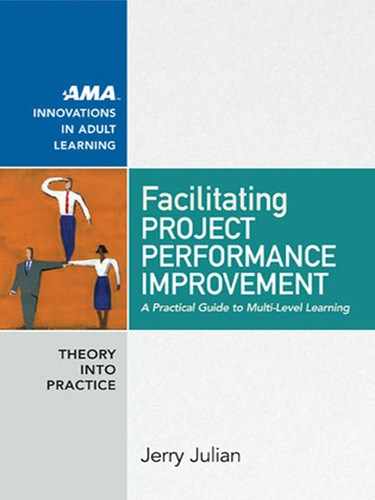Facilitating Level 2: Cross-Project Improvement 145
American Management Association
www.amanet.org
While improvements are being developed and implemented, team
members may want to keep a journal to record their thinking and other
events that occur along the way in preparation for the cross- project retro-
spective, the planning and conducting of which is covered next.
STEP 3: PLAN AND CONDUCT THE RETROSPECTIVE
After improvements have been made, either on one project or across mul-
tiple projects, the PMO leader and the coach work together to plan and
conduct a cross- project retrospective. This step consists of the following
activities: (a) Meet with participants individually, (b) gather data, (c) estab-
lish the agenda, date, and time, and (d) conduct the retrospective.
Step 3a: Meet with Participants Individually
The PMO leader or program manager may want to meet with group
members individually to provide support as they plan and implement po-
tential improvements for their respective projects, and he may work with
project managers, sponsors, or others to help pave the way for the use of
improved approaches.
Step 3b: Gather Data
Prior to the retrospective, the PMO leader asks each participant to develop
a timeline of the steps her team took over the course of its work. The
timeline should also include any signi cant events that may have occurred.
This will be brought to the session and shared with other members of the
group. As with the project retrospective, it is also useful to have factual
data related to actual person- hours, actual output (lines of code, for ex-
ample), and the number of defects, delays, or schedule slips that occurred.
Having these data will help in establishing a fact base for evaluating the
impact of improvements. Examples of the questions for data collection
might include the following:
1. What was the calendar time and number of person- hours required at
each stage?
146 Implementing Multi-Level Learning
American Management Association
www.amanet.org
2. What were the schedule slips on the project, and when did they occur?
3. How many defects were found at each stage, what was their severity?
4. What are the customer, internal client, or sponsor’s perceptions regard-
ing progress and results?
Step 3c: Establish the Agenda, Date, and Time for the Retrospective
As discussed in Chapter 2, the purpose of the cross- project retrospective
is to re ect on the steps that teams take to accomplish their work. The
agenda for this is similar to that for the project retrospective, except that
the focus is on the steps taken on more than one project. The retrospective
should result in answers to the following questions:
1. What was the problem identi ed at the outset, and what was our objec-
tive for improvement?
2. What actual results occurred after implementing these improvements?
What were the perceptions of the project team members, internal cli-
ents, customers, and other key stakeholders with regard to their e ec-
tiveness?
3. What were the primary causes or determinants of these results and
perceptions, whether favorable or unfavorable?
4. What worked well that we don’t want to forget?
5. What improvements will be carried forward into future activities, and
how will the knowledge transfer be accomplished?
The coach will design an agenda that addresses these questions based
on his style preferences, skills, and abilities. Like the prospective, the
meeting should start by reviewing the ground rules for group interac-
tion, including Kerth’s Prime Directive (see Chapter 3 for a more de-
tailed discussion). In addition, the following agenda items should also
be considered:
1. Review the improvement charter. This should be brief and to the point.
2. Share timelines. In the planning discussions, group members were asked
to bring a timeline depicting the steps their team took and any sig-
ni cant events that occurred. Allocate time for each person to discuss
Facilitating Level 2: Cross-Project Improvement 147
American Management Association
www.amanet.org
her timeline, signi cant data, improvements the she found useful, and
what she might do di erently next time.
3. Identify innovations. Working from their respective timelines, the group
members identify practices that improved results and should be in-
corporated into future projects. Questions to ask here include: What
worked well that we don’t want to forget? What did we learn from
this?
4. De ne additional improvements. The group discusses additional im-
provement opportunities that might be incorporated into future proj-
ect plans. If time allows, the list should be prioritized to collect the
team’s perspectives on which ones will have the most impact. Criteria
for prioritization might include impact on calendar time, work time,
customer satisfaction, quality, and/or employee development.
5. Determine if another iteration is required. Before ending the session, the
group, in consultation with the PMO leader, should decide whether
or not another iteration of improvement is required. It is likely that
signi cant problems will require multiple iterations to generate sus-
tainable improvement.
Norm Kerth (2001) and Esther Derby and Diana Larsen (2006) provide
a number of additional tools that can be used for process retrospectives,
including (for those familiar with quality tools) force eld analysis, ve
whys, and the shbone diagram, any of which can be useful depending
on the situation at hand.
Step 3d: Conduct the Process Retrospective
The retrospective is facilitated by the coach. As a skilled facilitator of
learning and improvement, he helps the group members look back on
their respective projects in ways that promote valid information, free and
informed choice, and internal commitment to changes. He helps people
collaborate e ectively, reminding people about tools such as TALK, the
Ladder of Inference, and collaborative con ict resolution (see Chapter
3 for a detailed discussion of how and under what circumstances the
coach should intervene to keep the group on track). When retrospec-
tives are conducted e ectively, groups will become increasingly skilled
..................Content has been hidden....................
You can't read the all page of ebook, please click here login for view all page.
